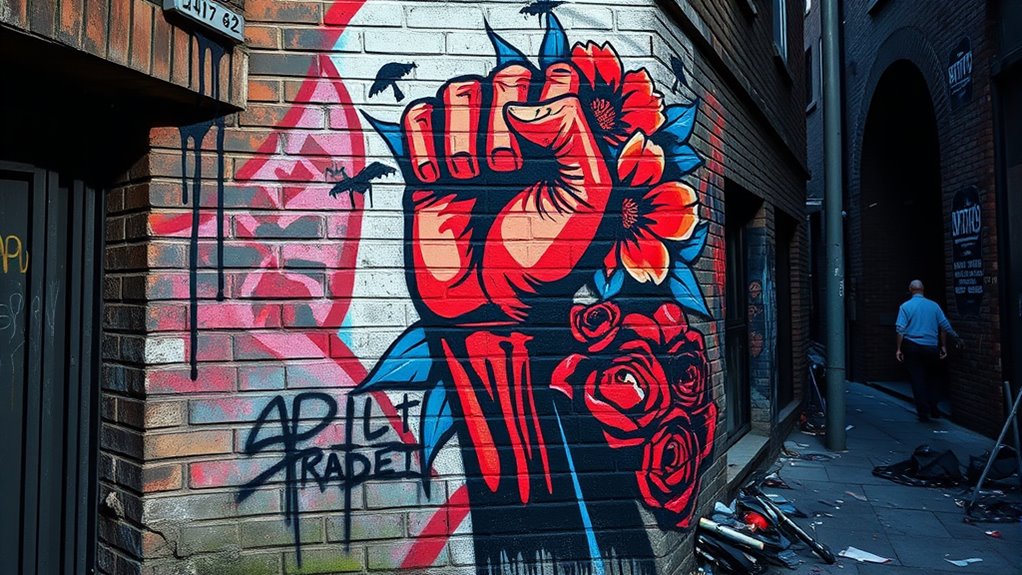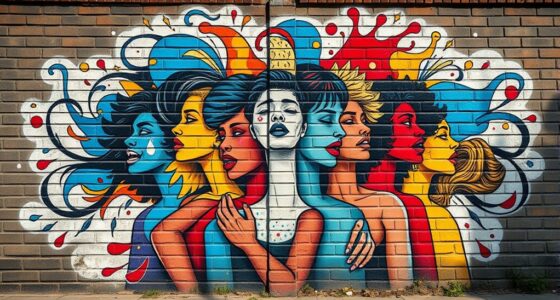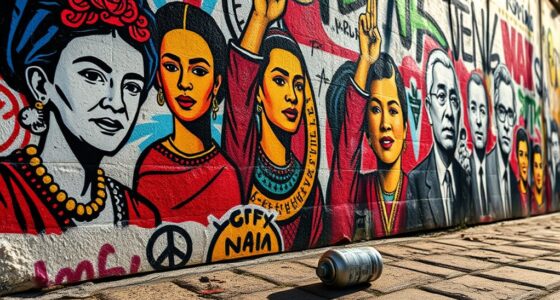Street art and protest graffiti turn city walls into powerful voices for social movements. You’ll see murals symbolizing resistance, cultural pride, and calls for change, often challenging authority and policy. Artists use bold symbols, colors, and techniques to communicate messages quickly and emotionally. These artworks raise awareness, inspire activism, and sometimes face risks like censorship or legal trouble. Keep exploring, and you’ll discover how these visual expressions continue to shape social struggles worldwide.
Key Takeaways
- Street art, including murals and graffiti, serves as a powerful visual tool to express social and political messages.
- Iconic murals symbolize social movements, fostering community unity and inspiring collective action.
- Symbols like fists and masks in graffiti evoke resistance and solidarity across diverse causes.
- Urban art raises awareness, challenges censorship, and influences public opinion and policy on social issues.
- Activists face legal, physical, and environmental challenges while creating street art for social change.
The Evolution of Protest Art in Urban Spaces

The evolution of protest art in urban spaces reflects how artists have continuously adapted their messages to challenge authority and address social issues. During periods of urban renewal, artists seize blank walls and neglected areas to highlight cultural identity and community struggles. As cities transform, protest art shifts from simple vandalism to powerful statements that reflect local histories and shared experiences. You’ll notice how murals and graffiti become tools for expressing cultural pride, resisting gentrification, and contesting dominant narratives. This ongoing dialogue between artists and urban environments demonstrates a dynamic relationship where public spaces serve as canvases for social commentary. The presence of local customs and community traditions often influence the themes and styles of protest art in different regions. Through these visual acts, you see how protest art preserves and elevates cultural identity amid urban change.
Iconic Murals That Shaped Social Movements
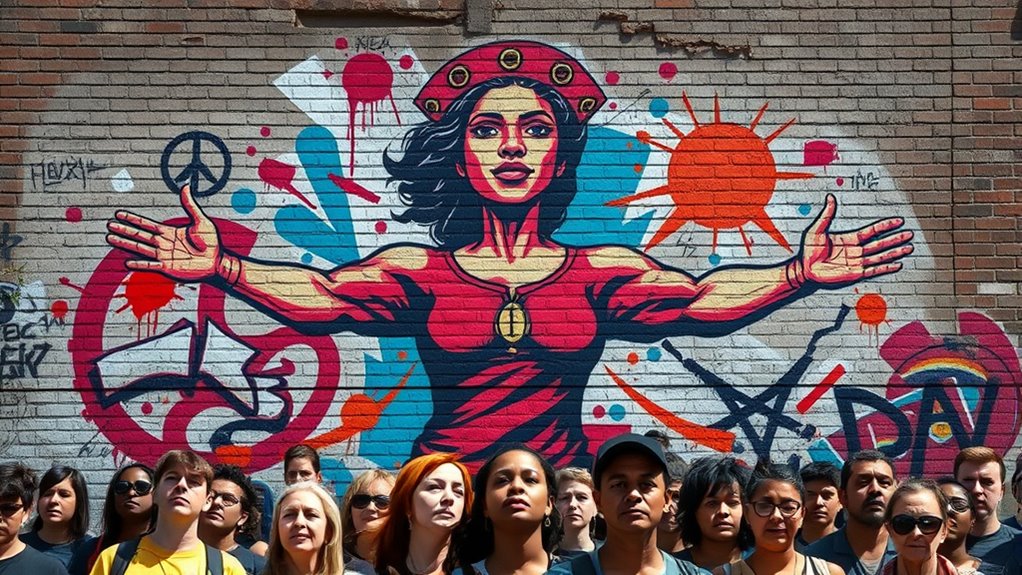
Throughout history, certain murals have become powerful symbols that ignite social change and unite communities. These murals serve as bold acts of political expression, embodying cultural identity and resilience. They influence public perception and inspire collective action. For example:
Murals inspire social change, embody resilience, and unite communities through powerful political and cultural expression.
- The murals of Diego Rivera highlight Mexican cultural identity and political struggles.
- The AIDS Memorial Quilt mural raises awareness and advocates for LGBTQ+ rights.
- The “Murales de la Muerte” in Mexico depict social injustices and resistance.
- The Berlin Wall murals symbolize the fight for freedom and unity.
- The Black Lives Matter murals express solidarity and demand justice.
These iconic murals go beyond art—they become visual voices that challenge injustices, celebrate cultural roots, and shape social movements. They remind us how art can spark change and foster community identity. Public perception is often shaped by these powerful visual messages, making murals a vital tool for social activism.
Techniques and Symbols in Protest Graffiti
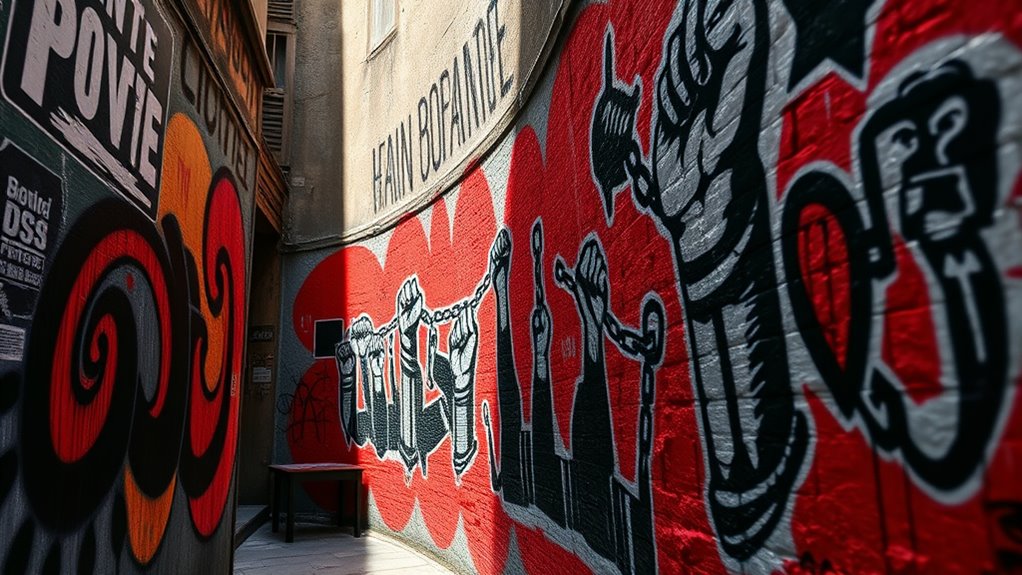
Protest graffiti employs a variety of techniques and symbols that amplify its message and captivate viewers. You’ll notice the strategic use of symbolic imagery, such as clenched fists, masks, or broken chains, which instantly communicate resistance and solidarity. Artists leverage visual rhetoric by combining bold colors, stark contrasts, and striking compositions to evoke emotion and emphasize their point. Stencils, posters, and spray paint are common tools that help craft quick, impactful messages. You may also see symbols like peace signs or political logos embedded within the artwork, reinforcing specific causes. These techniques and symbols work together to create powerful visual statements that transcend language barriers, making protest graffiti an effective form of social commentary and activism. Additionally, the use of visual symbolism enhances the emotional impact and clarity of the message, ensuring it resonates with a broad audience.
The Impact of Street Art on Public Awareness and Policy
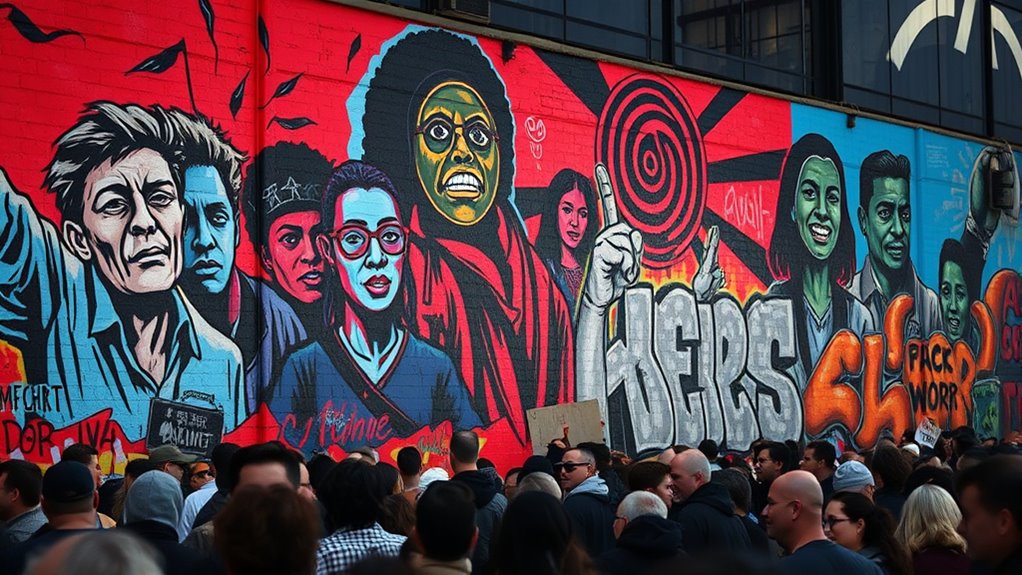
Street art has the power to raise public awareness and influence policy by capturing attention and sparking conversations. It often challenges government censorship, forcing authorities to confront issues they might prefer to suppress. Your community’s engagement with street art can amplify its message, making social issues more visible. When people see impactful murals or graffiti, they become more aware of pressing concerns and are motivated to act. This visibility can push policymakers to respond or reconsider decisions, especially when art resonates widely. Additionally, street art can highlight the importance of health benefits, emphasizing the need for community well-being and social support through visual expression.
Street art raises awareness and sparks change by confronting censorship and mobilizing communities.
- Sparks dialogue around social justice
- Challenges government censorship and suppression
- Mobilizes community involvement
- Raises awareness for marginalized groups
- Influences public opinion and policy decisions
Challenges and Risks Faced by Urban Art Activists
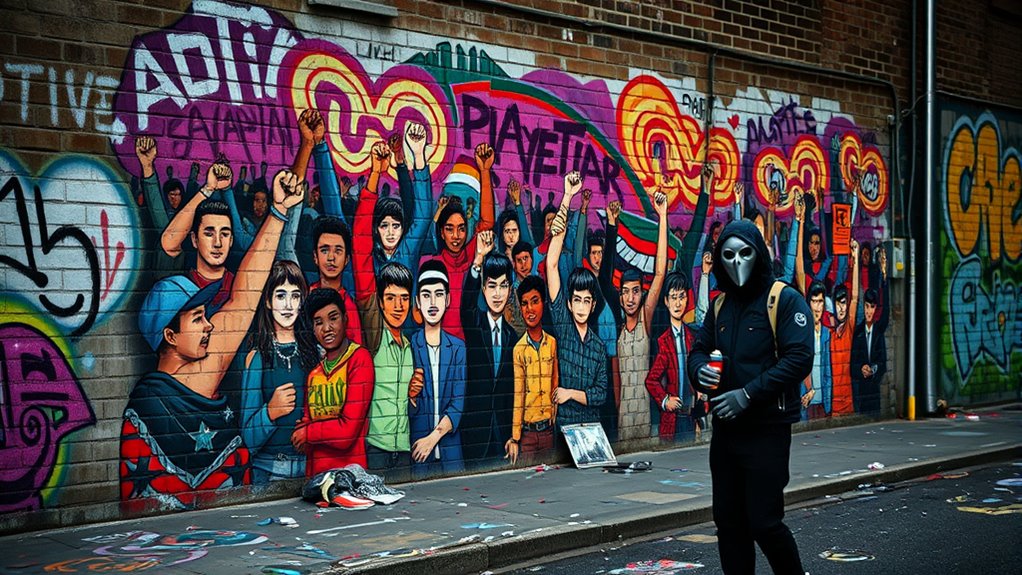
Urban art activists face numerous challenges and risks that can threaten both their safety and their ability to continue their work. Legal hurdles, such as fines, arrests, or even criminal charges, often target those who create unauthorized street art. These legal risks can discourage participation or push activists underground. Physical dangers are also significant; you might face confrontations with law enforcement or aggressive property owners, risking injury or arrest. Vandalism accusations can escalate quickly, especially in highly monitored areas. Despite these dangers, many activists persist, driven by the desire to communicate powerful messages. Still, the constant threat of legal action and physical harm creates a challenging environment that demands resilience, strategic planning, and a commitment to social change. Additionally, the durability of artwork can be compromised by weather conditions or removal efforts, complicating the activist’s goal of conveying lasting messages.
Frequently Asked Questions
How Do Governments Typically Respond to Protest Street Art?
Governments usually respond to protest street art with censorship and police crackdowns. They often paint over murals or remove graffiti to suppress dissent and prevent messages from spreading. Police crackdowns may include arresting artists or protesters involved, aiming to intimidate and deter future activism. You might notice authorities swiftly acting against street art that challenges power, trying to control the narrative and limit the visual voice of social movements.
What Ethical Considerations Surround Unauthorized Street Art?
You should consider vandalism ethics when creating unauthorized street art, as it involves respecting property rights and community standards. While artistic permission isn’t always granted, it’s important to weigh the message’s value against potential harm or defacement. Unauthorized art can raise awareness, but it also risks being viewed as vandalism. Think about whether your work communicates your message effectively without damaging property or violating ethical boundaries.
How Does Street Art Influence Youth Engagement in Activism?
Your eyes are the canvas where street art sparks youth empowerment and visual activism, turning passive viewers into active participants. It influences you by making social issues tangible and urgent, inspiring you to join the conversation. As vibrant murals and graffiti become your rallying cry, they ignite a sense of ownership and responsibility, transforming you from a bystander into a voice for change within your community.
Can Street Art Be Effectively Preserved for Historical Purposes?
You can preserve street art effectively by creating detailed documentation through photographs and digital records, helping to overcome preservation challenges like weather damage or vandalism. To guarantee historical significance, you should advocate for legal protections and dedicated preservation efforts. While capturing its essence for history is possible, active engagement and community support are essential to overcoming preservation challenges and maintaining street art’s cultural and historical value for future generations.
What Role Do Digital Platforms Play in Spreading Protest Art?
You might think digital platforms dilute protest art, but in reality, they amplify it. Digital amplification allows your art to reach a global audience instantly, turning local protests into viral dissemination sensations. Social media enables your visual voices to break barriers of time and space, ensuring your message resonates far beyond the streets. So, ironically, digital platforms become the loudest megaphones for your protest art.
Conclusion
As you walk through city streets, remember that nearly 60% of urban murals have sparked conversations or policy changes. Your presence amidst these vibrant displays fuels their power as voices of social change. Street art isn’t just decoration; it’s a dynamic force that challenges, inspires, and unites communities. So next time you see a mural or graffiti, realize you’re witnessing a visual protest—a bold call for justice waiting to be heard.
